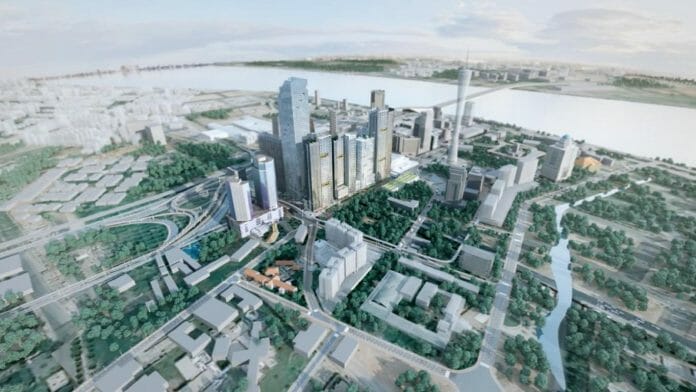From its origin as a fishing village to being the capital of the Johor Sultanate, Johor Bahru has undoubtedly amassed a great wealth of heritage. The modern city is intertwined with aged-old customs, and is better described through the this poem:
Through the vista of our five-foot ways
A treasure trove from the years speak volumes
Honoring, commemorating, glorious
Every characterful mile interlaced in harmony
Steeped in rich culture and proud traditions
Inspiring, uniting, cherished
Yet transient as shadows will our identity be
Lest into the future we fuse our past
Respecting, preserving, enlightened
This poem is dedicated to the Ibrahim International Business District (IIBD), a 250-acre gazetted area within Johor Bahru city centre, to commemorate the Heritage pillar of the business district. The continuity of culture amidst change is crucial as the community of Bangsa Johor progresses with the times. Not merely looking back and cherishing the good old days, but building upon the past is necessary in paving the path for the future!
Heritage, the Catalyst for Harmony
Second of the four IIBD blueprint pillars to be launched, Heritage has a vital role in creating an ideal environment involving both locals and internationals in the progress and success of IIBD. The Heritage Cornerstone, a 22-feet artistic sculpture at Legaran Segget and adjacent to the archway of the Tan Hiok Nee Heritage Street, stands as a reminder for all Bangsa Johor of their responsibility in building upon their culture, and strengthening it as time passes.
The IIBD Heritage Cornerstone signifies the celebration of Johor’s diverse cultural legacy, showcased through the local traditional design elements of the Urban Tree. Symbolising the three main ethnic groups in Johor, the cornerstone is made up of three metal branches that extend upwards and outwards to form a broad leaf covering and reveal pattern cut-outs dispersed on its surface. The various cut-outs are inspired by cultural motifs found on existing heritage buildings in IIBD, paying tribute to the richness of Johor’s multiracial and multicultural treasures. The Heritage Urban Tree is an interactive sculpture through shadow play, symbolising the unity and beauty of cultural heritage that needs to be preserved and celebrated.
Catching a Glimpse of IIBD Heritage Sites
Within IIBD, there are numerous other heritage sites earmarked as precious gems for preservation. These sites carry great meaning in shaping the Bangsa Johor identity as physical reminders of the legacies the forefathers left behind.
Strolling along Jalan Tan Hiok Nee down to Jalan Segget, the teeming Bazaar Karat pasar malam stretches across these streets. Engulfed in a myriad of multisensorial treats the market offers, songs of buskers and chatter of vendors fill the air amid the stalls. From yummy food to baby strollers, quirky phone casings, and even home-made skin care remedies, the good folks at Bazaar Karat have got it covered.
A Place for Johor Bahru’s Diverse Devotees
From stateliness to spirituality, the Streets of Harmony prove that peaceful coexistence and unity of people with different cultural and religious backgrounds is beyond aspiration – it’s a reality. Spanning across Jalan Gereja, Jalan Trus, Jalan Dhoby and Jalan Duke, the six different houses of worships are testament to the unique identity of Bangsa Johor dating back to early 19th century.
One of these places of worship is the Johor Gu Miao temple. It houses deities revered by the five main dialect groups namely Hainanese, Cantonese, Hakka, Hokkien and Teochew, and is called “the temple of unity”. The modest temple is thought to be the first Chinese temple in the nation named after a state, due to the good relationship between past Johor ruler Temenggong Ibrahim and Chinese immigrants.
Not far away is the whitewashed Church of Immaculate Conception, the oldest church in Johor Bahru. The church showcases its 1920’s British Colonial architecture, looking nothing like the funeral parlour it originally was. Right in front at the entrance is a marble statue of Our Lady, a gift from past ruler Sultan Ibrahim, serves to be more than just a decoration piece.
With the arrival of Indian immigrants in the early 1900’s, came a need for a place of worship. Upon appeal, past ruler Sultan Ibrahim granted a site for a temple to be built and graciously gave a huge sum of donation for its construction. Staying true to its name, the vibrant Sri Raja Mariamman Temple bears honor to the sultan with the word “raja” being incorporated into its name.
Staying on Course with Heritage
The Johor Bahru Old Railway Station, once an intercity railway station still flaunts a cheerful exterior with its contrasting colours and western architecture. A sense of old-school wanderlust lingers in the air, and one can’t help but be drawn to its charm – even if the tracks have stopped running.
Finally, away from the hustle and bustle stands the stately Bangunan Sultan Ibrahim. Its architecture is the result of when east meets west – with Johor Malay, Islamic and British Colonial elements blended seamlessly together. Although construction was briefly paused due to the war circa 1940, that did not stop it from being the earliest skyscraper in Johor Bahru, towering above other buildings until the swinging 70’s! Though today, it accommodates the Johor State Government as an administration hub, its timeless role as a monumental architecture still remains.









